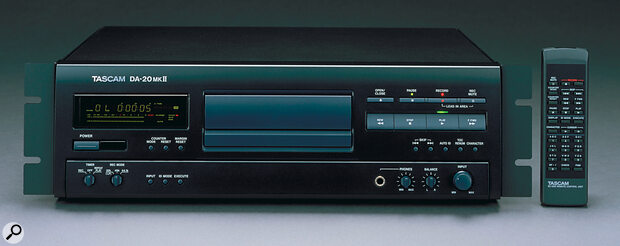Paul White checks over the latest incarnation of an old friend.
DAT recorders are admittedly pretty unexciting at the best of times, but DAT nevertheless represents the closest we've yet come to as a standard mastering format, and choosing the right model of recorder is important. Very cheap budget DAT decks are tempting, but experience has shown that they don't usually last too long before giving you problems. On the other hand, if you spend too much, you can be paying for features you don't really need. Tascam's original DA20 occupied the cheaper end of the middle ground and turned out to be a very reliable studio workhorse — mine was one of the first, and it's still going strong. Now the company have significantly upgraded the model while dropping the cost slightly.
So What's New?
The DA20 MkII is a 3U rackmounting DAT recorder with unbalanced phono ins and outs, and S/PDIF digital I/O also on phonos (the lack of balanced analogue I/O is about the only sign that this is not a thoroughly professional machine). The dreaded SCMS digital copy protection system is present, but it can be turned off, and unlike strictly consumer DAT machines, the sample rate can be set to 48kHz or 44.1kHz as well as to a 32kHz long‑play mode via a front‑panel rotary switch. You don't get the jog/shuttle feature of the more costly DA30, but audio can be fast‑cued by pressing either the fast‑forward or rewind buttons while the machine is in play. Most of the features are the same as on the original DA20; in addition to the normal track ID features, there's the ability to name tracks and to create a table of contents at the beginning of the tape to facilitate fast searches of individual tracks. I must admit, I've never used this on my DA20, but it's there if you want it. There's also a distinctly consumer feature that automatically turns CD track IDs (Q codes) into DAT start IDs when making a digital copy from an audio CD.
The DA20's internal mechanism has also undergone a major electronic redesign, which has added a few new features. To improve the sound quality, both the A‑D and D‑A converters have been upgraded to newer delta‑sigma devices, and the audio signal path has been similarly optimised. The error correction system has also been made more robust, which should mean fewer incompatibility problems when playing tapes made on other machines, but best of all, an error rate display function has been added. This is accessed while in stop mode by pressing the Counter Mode button at the same time as the Rec Mute button, after which the tape can be played to show the error rate. Separate error rates are shown for the two heads (A and B) on the drum as well as a combined mean error rate, and you can scroll around the three error figures with the Auto ID button.
When recording from an analogue source, the track start IDs are triggered by the audio signal crossing a threshold, but sometimes this can lead to the IDs being positioned slightly late. In the DA20 MkII, the audio detection thresholds can be set to between ‑60dB and ‑30dB in 10dB steps (the factory default is ‑50dB). Another potential problem with some DAT machines is that to monitor the input signal, you have to enter the Record Ready mode with the tape engaged. However, the DA20 MkII has a new sampling monitor function that works if you press Record while the transport is stopped. This passes the input signal through to the outputs, both analogue and digital, as well as metering the level, but without the tape being engaged, so you save your tape and heads unnecessary wear. Obviously, this is useful for level‑setting, but it also means the DA20 MkII can be used as a stand‑alone A‑D converter for feeding S/PDIF‑compatible soundcards and suchlike.
The final major upgrade is the inclusion of a self‑diagnostic system that puts up error messages if certain fault conditions exist. As with most error readouts, this one is pretty cryptic, but the seven different error conditions are clearly explained in the manual, ranging from condensation and stiff tapes to broken tapes or faulty mechanisms.
Verdict
I've always found the DA20 to be a straightforward, fine‑sounding DAT recorder, so the sonic improvements in the DA20 MkII are quite subtle, but having a proper error readout is very welcome, as are the other enhancements described earlier. In my view, the only real weakness of this machine for professional applications is the use of unbalanced phonos for the analogue ins and outs, though in most private studios, that won't compromise the quality of the final recording. If you haven't used a DA20 before, you'll almost certainly appreciate the clearly set‑out control panel and the positive transport. The DA20 MkII is identical in layout, and although there are some consumer features you may never use, they are arranged so as to keep out of your way unless you want them. In value terms, one of the best deals in studio DAT machines has just got a little better and a little cheaper, which is not to be sniffed at!
Pros
- SCMS can be switched off.
- Good sound quality.
- Clear user interface.
- Genuinely useful new features, including an error readout.
Cons
- Analogue ins and outs on unbalanced phonos only.
Summary
The DA20 MkII offers just about the perfect combination of price, reliability and features to make it the ideal project studio mastering machine.

